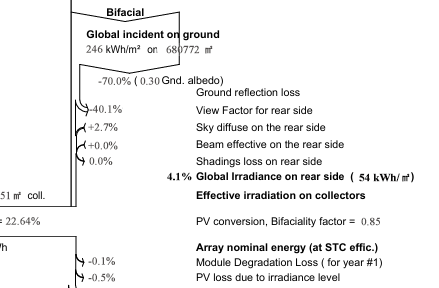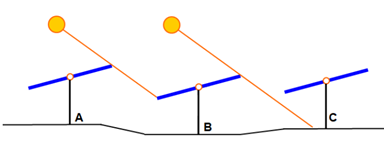1.How to Calculate the power generation gain of the back side of Bifacial system?
Answer: During the simulation, you can first choose single-sided simulation and then select Bifacial system. By subtracting the power generation of the two, you can calculate the theoretical power generation of the back side.
2. What is the difference between the back radiation gain and the power generation gain in a bifacial system?
Answer: The backside radiation gain is an optical gain, which is different from the electrical gain. Therefore, the optical gain cannot represent the bifacial power generation gain. For example, as shown in the figure below, the backside radiation gain is 4.1%, and the actual effective backside radiation gain needs to be multiplied by the bifaciality factor of the PV modules. The power generation gain can be obtained through single-sided simulation and bifacial simulation. In this example, the single-sided power generation is 152,089 MWh, and the bifacial power generation is 156,416 MWh. Therefore, the bifacial power generation gain is 2.84%.

3. How to Calculate the system efficiency of Bifacial system?
Answer: The traditional PR algorithm theory does not include the yield from the back side in its calculation, so the calculated PR value incorporates the gain from the back side. The system efficiency of a bifacial system can be calculated according to the latest IEC specifications. In the latest PVsyst version, the system efficiency (PR) and bifacial system efficiency (PR) can be viewed on the simulation results page. The relationship between the two can be referred to in the formula below. Here, GloBak represents the radiation amount on the back side, BackShd denotes the radiation loss due to shading on the back side, and GlobInc signifies the radiation amount on the front inclined surface.
PRbifi = PR / (1 + (GlobBak - BackShd)/(GlobInc))

4. Can PVsyst simulate the production of Bifacial system?
Answer: It cannot be simulated temporarily.
5. Why is the loss of weak light power generation a positive percentage?
Answer: Weak light performance refers to the varying conversion efficiency under different irradiations. Under specific irradiance, the conversion efficiency may exceed that of STC. If this ratio is high, it may be positive.
6. Which type of Loss is it below?
Answer: Combiners come with built-in anti-reverse diodes to prevent losses. Generally, combiners are not equipped with anti-reverse diodes, so you can leave it unchecked, and the voltage will be 0V.

7. The data of MN8.0 was revised using Soalrgis data, and the orientation data in the engineering project was shown to have been modified. However, after simulating the operation, the meteorology data remained unchanged from before the modification. What should be done?
Answer: You can create a new SIT meteorological data File and then re-synthesize the met data File.
8. Can PVsyst export a one-year predicted power curve?
Answer: Yes, it can be exported. Depending on the source of meteorological data and time series, power curves for typical meteorological years or a specific year can be exported.
9. What is Global Incident below threshold loss? Why can't we see it now?
Answer: The power generation loss during simulations when the GlobInc value is below a given threshold. This threshold is fixed at 10 W/m2, and generally, this loss is very small, not exceeding 0.05%, and is not displayed in the energy loss diagram.
10. When using unlimited sheds, does the number of rows in the array affect the results?
Answer: Yes. It's best to confirm based on the actual layout drawings.
11. Can inverse tracking technology be used in PV systems for upland power stations?


Article Comments(0)